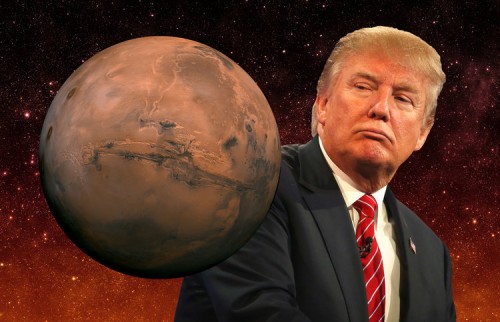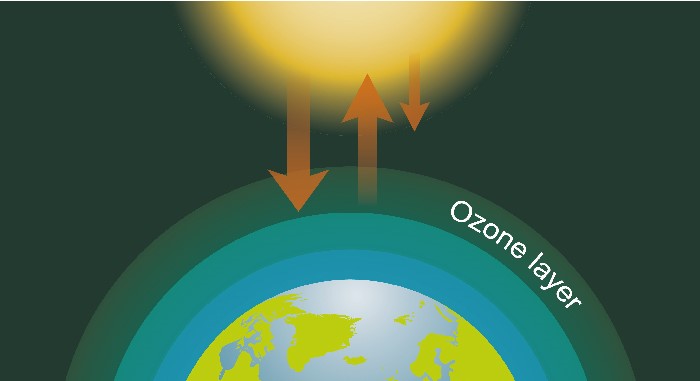The April 24, 2017 video call to congratulate the astronaut Peggy Whitson, who that day broke the record to become the American who has spent the longest amount of time in space, was an unusually smooth public event for the president.
Trump sat at his desk in the Oval Office, flanked by his daughter and adviser, Ivanka, and astronaut Kate Rubins, and read prepared remarks off a sheet of paper while other members of his staff — Jared Kushner, Reince Priebus, Sean Spicer, and Betsy DeVos — looked on. Suspended aboard the Space Station, Whitson and Colonel Jack Fischer fielded his questions, including, "What are we learning by being in space?"
The only major hiccup visible to the public came when Trump asked about Mars. "Tell me, Mars — what do you see a timing for actually sending humans?" he said. Whitson responded by noting that just a month earlier, Trump had signed a bill outlining such timing. "Well, I think as your bill directed, it would be in the 2030s," she said. "Unfortunately spaceflight takes a lot of time and money, so getting there will take some international cooperation."
Trump didn’t accept her answer. "Well, I think we want to do it in my first term or at worst in my second term," he said. "So I think we’ll have to speed that up a little bit." By Trump standards, the comment barely registered as news. The New York Times suggested he’d said it "perhaps jokingly."
But Trump wasn’t joking. He was suddenly very serious about getting to Mars as soon as possible.
From the moment Sims broached the subject of the video call to the Space Station with Trump, it seemed to inspire in him a chimerical mood. "We don’t capture people’s imaginations anymore," Trump said, in what Sims described as "a rare moment of wistfulness." Trump continued: "We used to do big things — incredible things. No one could do the things we could do. You have to inspire people. They went to the moon. But the call would be great. Honestly, how cool is NASA?"
Sims detailed the logistics of setting up the call, something that required NASA engineers and diagrams of the Oval Office and a walk-through beforehand. But the most important aspect of the plan, Sims learned, would be the timing. An engineer explained something called "orbital mechanics" to him, how the Space Station would only be reachable during a specific period of about 20 minutes when it was in just the right place. "The President would have to be right on time, a rarity," Sims wrote.
The day of the event, Sims conducted a final briefing in the Private Dining Room with Trump, DeVos, Rubins, and Robert Lightfoot Jr., the acting NASA administrator. "We had about ten minutes before the broadcast," Sims wrote, "which I stressed to the President had to start and end exactly on time."
As Sims explained to the president what was about to happen, "he scanned over his prepared remarks, crossing out some of the text with a Sharpie." Meanwhile, Sims wrote, "the giant flat-screen TV hanging on the wall was turned to Fox News, on mute." Trump asked him where the cameras would be positioned and "which side of his head would be most prominently featured." Sims wrote that he "made sure the press cameras would be positioned on the right side," which was Trump’s preference.
Then, something happened. Trump "suddenly appeared distracted, distant," wrote Sims. "I could sense the gears inside of his head starting to turn. I was losing him." As the clock ticked down, Trump "suddenly turned toward the NASA administrator." He asked: "What’s our plan for Mars?"
Lightfoot explained to the president — who, again, had recently signed a bill containing a plan for Mars — that NASA planned to send a rover to Mars in 2020 and, by the 2030s, would attempt a manned spaceflight.
"Trump bristled," according to Sims. He asked, "But is there any way we could do it by the end of my first term?"
Sims described the uncomfortable exchange that followed the question, with Lightfoot shifting and placing his hand on his chin, hesitating politely and attempting to let Trump down easily, emphasizing the logistical challenges involving "distance, fuel capacity, etc. Also the fact that we hadn’t landed an American anywhere remotely close to Mars ever."
Sims himself was "getting antsy" by this point. With a number of points left to go over with the president, "all I could think about was that we had to be on camera in three minutes … And yet we’re in here casually chatting about shaving a full decade off NASA’s timetable for sending a manned flight to Mars. And seemingly out of nowhere."
Trump did not seem worried about the time. Sims wrote that he leaned in toward Lightfoot and made him an offer. "But what if I gave you all the money you could ever need to do it?" Trump asked. "What if we sent NASA’s budget through the roof, but focused entirely on that instead of whatever else you’re doing now. Could it work then?"
Lightfoot told him he was sorry, but he didn’t think it was possible. This left Trump "visibly disappointed," Sims wrote. "But I tried to refocus him on the task at hand. We were now about 90 seconds from going live."
Trump wasn’t ready to refocus yet, however. As he walked with Sims from the dining room to the Oval Office, he stopped just outside the door. "He decided to stop in his white-marbled bathroom for one final check in the mirror," Sims wrote. He had 30 seconds before he was supposed to be on camera, and Sims was "now nearing full on panic."
In the bathroom mirror, Trump smirked and said to himself, "Space Station, this is your President." He told Sims to go ahead into the Oval, assuring him, "I’ll be right in."
He made it with barely a second to spare. "If I’d ever doubted that his showbiz background actually brought any value to this job, I certainly never would again," Sims wrote.

Donald Trump nearly derailed a televised call to the International Space Station after he got distracted, first by a sudden fantasy of going to Mars before the end of his first term in the White House, and then by a trip to the bathroom to check his reflection in the mirror, according to Team of Vipers, a new book by Cliff Sims, who worked as a communications official for Trump on his presidential campaign and in the West Wing.




